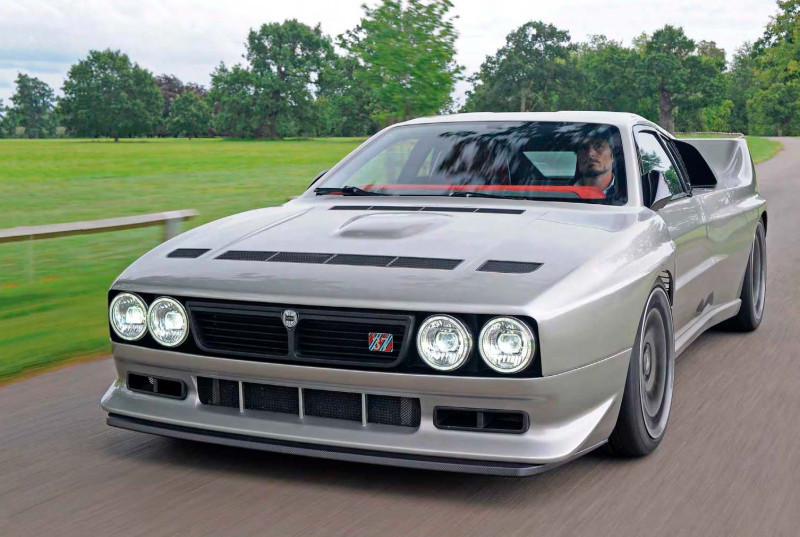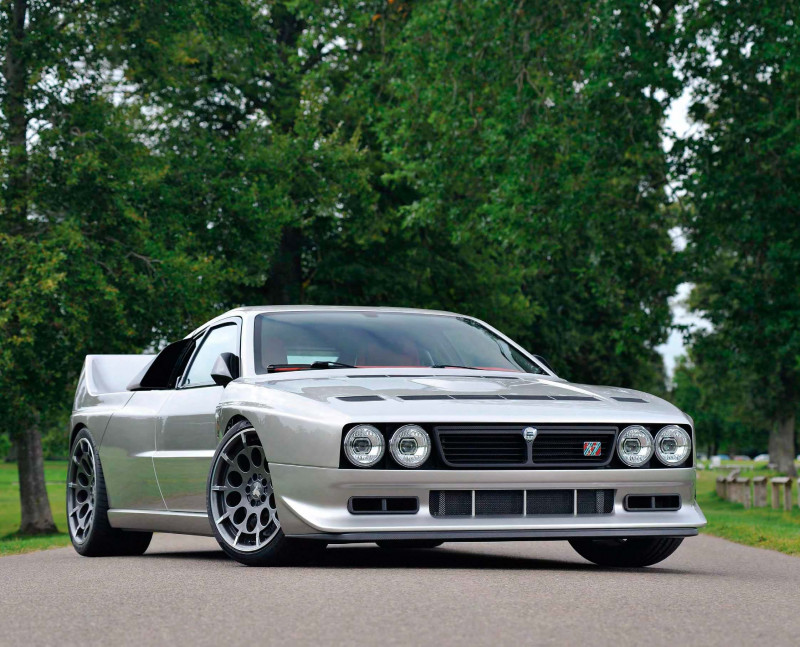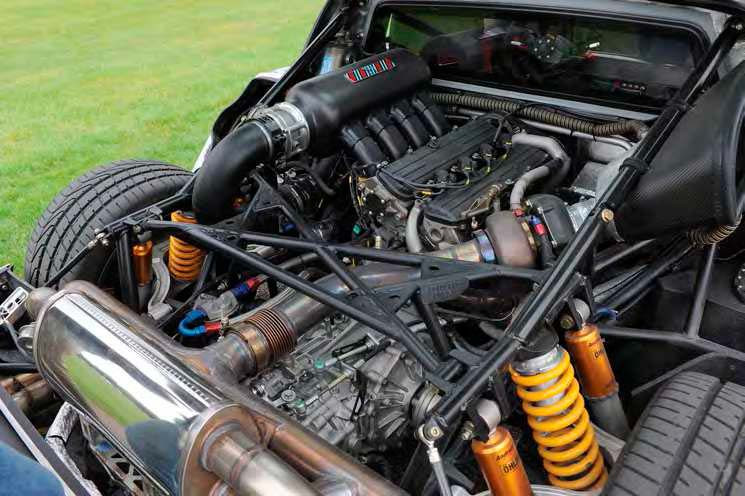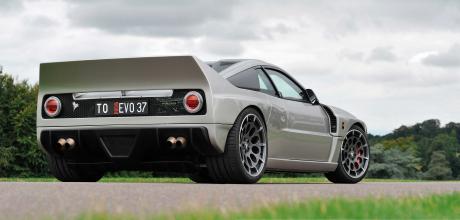2022 Kimera EVO37
What if Lancia still made its world championship-winning Rally 037 today? Now we know what it would feel like: the new Kimera EVO37 completely modernises Lancia’s icon with superb results, as we discover on a first drive Story by Chris Rees. Photography by Michael Ward.
KIMERA EVO37 DRIVEN EXCLUSIVE! LANCIA RALLY REVIVAL
EVOLUTION of the Species — Lancia Rally 037 reinvention: exclusive test
So here it is in front of me, bristling with purpose, a beauty and a brute both at the same time, its engine burbling with intent. The creator of this new Italian car, dubbed the Kimera EVO37, is a genial chap called Luca Betti and he’s just invited me to drive his new baby. Excited? Me? Surely not. Sweaty palms and a silly grin tell a different story. However vanishingly short my drive of this pre-production prototype may be, the excitement is genuine because this is, for me, the most anticipated newcomer of 2021.

If you could roll together all the elements that most excite me – little things like a world rally championship-winning pedigree, rear-wheel drive, brutal performance and analogue controls – the new Kimera EVO37 has it all in spades.
Kimera Automobili, based in Cuneo in Italy, may be a small company but it’s making big waves. It was founded by 43-year-old ex-rally driver, Luca Betti. Racing is truly in his blood: his father and uncles were all racing drivers and his parents met at a race. However, when his mother didn’t want Luca – the only male of eight children – to follow the family’s racing roots, he insisted. He went on to become a WRC rally driver but after losing his works seat, he set up a company called KMR, standing for ‘Keep My Road’. It was only a short hop to the name Kimera, a mythical creature from Greek legend. In English, a chimera is a single organism made up of two or more organisms, which seems perfect for the EVO37. Oh, and in Italian, to ‘follow your chimaera’ means to chase impossible dreams – again a perfect analogy. As Luca comments: “A life spent dreaming is the perfect life, and that’s just what I’m doing!”
The Kimera EVO37 certainly looks dream-like. It’s absolutely spectacular in the flesh. The concept was all Luca Betti’s but he admits he’s not a car designer and so of course he sought help. Among his talented team was a certain famous designer whose identity, sadly, we are not at liberty to divulge. Suffice to say that he’s designed one of the world’s most lauded current supercars…
Like the original 037, the Kimera uses the centre section of an original Beta Montecarlo (which incidentally eases the registration process no end). There’s a degree of ‘reverse engineering’ involved, too. Kimera’s background is restoring and building Lancia 037 and Delta S4 cars (both Stradale and Group B), so it has a deep knowledge of what makes these things tick.

However, other than the Montecarlo centre section, everything else on the car is completely new. Freshly developed tubular framework front and rear is resolutely modern in specification, designed using computer modelling and made of molybdenum chrome steel. All of the componentry is cutting-edge, too, from Pirelli run-flat tyres to adjustable Öhlins dampers to Brembo brakes. The construction techniques and materials are also very much 21st century, including Kevlar, titanium, aluminium and – above all – carbon, out of which the whole body is made.
What really makes the EVO37 so special is the involvement of so many of the team members who created the original Lancia Rally 037 back in 1982. Chief among these has to be Sergio Limone, who was intimately involved in the development of the new Kimera chassis, as Luca Betti explains: “He was very important in the process, suggesting ideas at every stage. He was always very attentive and whenever he saw something and said ‘hmmm’, we knew we had to change it immediately. He is the professor!”
It’s a similar story with the engine, with Claudio Lombardi on board to guide the development of the new power unit. He was the man in charge of all the engines in Lancia’s classic ‘Martini’ era. Of special significance was his work on the Delta S4 engine, a true monster of rallying, whose essential concept is used in the Kimera: a supercharger to boost torque at low revs and a turbocharger to add power at higher revs – although the supercharger now has electric rather than pneumatic actuation.

The chassis and subframes have been engineered by Bonetto, with a set-up that echoes the Lancia Delta S4’s. Engine development has been by Italtecnica. Apart from the cast-iron four-cylinder twin-cam block (which is original), everything else is completely new. It retains a modest capacity (just 2150cc) but succeeds in extracting incredible peak power of 505hp. For the record, 235hp per litre is the highest specific power output of any road car powerplant. There’s one other person to name-check: rally driver Miki Biasion, who has been testing the car – very fittingly considering he won both the Italian and European Rally Championships in 1983 in a Lancia 037.
Some cars just look and feel ‘right’. The Kimera is definitely one of those. It’s physically bigger than the 1982 original (165mm longer and 105mm wider) but has reduced front and rear overhangs. Because of the increased track width, the wheelarches are massively flared. Cleverly, they pick up on the famously chiselled profiles of the Delta integrale Evo, giving the car a truly muscular presence. In so many of its details, you really appreciate the small things, like the rear badge that reads ‘Autentica Evoluzione’ (Authentic Evolution), using exactly the same font as Lancia’s integrale – a neat touch. Luca Betti tells me: “We use the word ‘authentic’ very small because we don’t have to say it at high volume to the world. We keep the tradition and philosophy of the original car, its soul. This is not a restomod, though. It’s a brand new car, as Lancia would be making today if had kept going with the 037. It’s a modern car that respects the legacy of the Rally 037.”
One thing draws my attention more than anything else: the achingly beautiful wheels. Kimera’s ‘secret’ designer has done a stellar job here. Wheels so often make a car, and here is a case in point. They synthesise elements of classic Lancia designs, in particular the Delta integrale 16V with its anthracite centres, but very much modernised.
Quad LED headlamps are also resolutely modern but still in keeping with the classic theme, recalling the ‘eyes’ of the 1982 Rally 037. Even the metallic grey paint – not perhaps an obvious choice for this car – looks great. It’s inspired by an original Delta S4 colour and has been created to look distinctive in different lights and to highlight the shape of the car.
Stepping inside, the cockpit looks and feels superb, exactly like a ‘Stradale’ version of a rally car should. This pre-production car is very near to the finished spec but some parts have still to be finalised, such as the sills (which will be in carbonfibre), the climate control knobs (which will be in machined aluminium) and the steering wheel. The unique Kimera-branded instruments are as they will be in terms of layout and design, even if they’re not the definitive production spec yet. I love the classic orange-on-black look and the separate boost gauges for the supercharger and turbo, while an LCD screen has even more detailed parameters and doesn’t look remotely out of place in the Alcantara-lined centre console. The rows of little red buttons above it configure various electronic settings.
The superb ribbed seats are a mix of Delta S4 Stradale and Rally 037 Stradale themes and look just sensational. They’re comfortable to sit in, too, the optional racing harnesses holding you firmly in place. By the way, customers can personalise all colours and materials using a virtual reality oculus. OK, it’s time for my test drive. Starting the car is akin to a fighter plane: prime two red switches, then press together two little black buttons on either side of a small binnacle and the four-cylinder engine burbles into life. A few discreet dabs of the throttle immediately call attention to the exhaust: loud, snarling and head-turning.
I’m warned about the clutch, which is to competition spec and very sharp (production cars will have a 184mm dry twin-plate hydraulic clutch). Sure enough, it’s ultra-sharp and I stall on take-off. I clearly need to use a lot more revs to get it off the line. Not remotely a chore, given the sweet, sweet sound of the engine.
A short acceleration up the road reveals the instant kick on tap. Clearly audible mechanical whine betrays why: the supercharger is already working to give you plenty of torque even at very low revs. By 2000rpm you’ve already got all of 400Nm, plenty enough to break traction if you hoof the loud pedal, and further up the rev range peak torque is a huge 550Nm. As your revs rise, a distinctive whistling introduces part two of the power boost story: the turbocharger kicking in. If I thought the Kimera was fast off the line, the jump in performance with the turbo in full flow comes as a real wake-up. With only 1100kg to haul (and this is before new carbonfibre parts reduce the weight to a target of 1050- 1080kg), it scampers off like… well, like a Group B rally car.
While a sequential automatic gearbox is available, if ever there was a car that calls out for a manual transmission, this is it. Luckily, it’s got a great manual gearbox: the same six-speed ’box used in the Lamborghini Gallardo. The gearchange is ultra-mechanical yet slick. A three-point turn reveals how brilliant the gear lever is: a real work of art, its metal base a sculptural focus that mimics the reverse-gear lock-out of the original 037 Group B racer. The manoeuvre also provides evidence of how much feel there is in the power-assisted steering.
A few other initial impressions. Considering the ultra-low-profile tyres (245/35 R18 front and 295/30 R19 rear), the ride is surprisingly good. Visibility is very tricky with that enormous rear spoiler blocking any view out of the back and the door mirrors being so tiny. As for the brakes, this pre-production car has no servo, so the pedal requires some hoofing – perfect if you’re a rally driver like Luca, but he recognises that most customers prefer servo assistance so this will be fitted to production cars.
My drive is too brief to get full cornering impressions but Luca reassures me: “We are fortunate in following a brilliant original concept in the Rally 037. I was surprised to find that the set-up was pretty much spot on from the first drive. It’s so precise, so fast entering the corners. The wide track, suspension and tyres make this an incredible car on twisty roads.”
Although not set up as a track machine, it’s well suited to both road and track use, says Luca. It’s more comfortable to drive than a Ferrari, he says, and I do take his point in many respects. Incidentally, Luca Betti has ruled out an ‘integrale’ version with four-wheel drive.
It’s great news that you can buy the Kimera today, with the first deliveries expected in October. Even priced at €480,000 each, you’ll need to hurry if you want one. Only 37 are to be made and at the time of writing, 21 have already found homes, from the UK to the USA, Switzerland to Japan. Right-hand drive is perfectly possible, by the way, using an original RHD Beta Montecarlo.
It’s an equally great pleasure to report that the Kimera EVO37 does not disappoint on any front. It’s a brilliant car that lives up to every millimetre of the promise of its looks and specification. The quality of design, engineering and manufacture are impeccable. It certainly helps that the team behind it is such a serious one, including several of the original people who conceived Lancia’s original 037, to the which the Kimera pays perfect homage.
ORIGIN STORY
Lancia’s Rally 037 provides the clear inspiration for the Kimera. First seen at the 1982 Turin Show, it immediately started winning in rallying, taking the 1983 WRC constructors’ title after victories in Monte Carlo, Corsica, Greece, New Zealand and Sanremo – the very last two-wheel drive car to win the world rally title.
Despite the arrival of four-wheel drive in WRC, the rear-wheel drive 037 continued to win: in 1984, it took the Tour de Corse, for instance, while it also won the European championship in 1983, 1984 and 1985. Some 200 road-going ‘Stradale’ versions were built to comply with Group B regulations. Genuine Rally 037s are today worth anything between £350,000 and £650,000.
TECHNICAL SPECIFICATIONS 2022 Kimera EVO37
- ENGINE: 2150cc 4-cyl turbo & supercharged
- BORE X STROKE: 85mm x 95mm
- COMPRESSION RATIO: 7.5:1
- MAX POWER: 505hp at 7000rpm
- MAX TORQUE: 550Nm at 3900rpm
- TRANSMISSION: 6-speed, rear-wheel drive
- BRAKES: 365mm vented discs front & rear
- TYRES: 245/35 R18 (front), 295/30 R19 (rear)
- DIMENSIONS: 4055mm (L), 1905mm (W), 1200mm (H)
- WEIGHT: 1050kg
- 0-62MPH: 4.0sec
- PRICE: €480,000
Wheels synthesise several Lancia designs. Gear lever is a work of art, as are the Delta S4-inspired seats. Supercharger and turbo combine to produce huge torque at all engine revs. Quality is impeccable.
“A few discreet dabs of the throttle immediately call attention to the exhaust: loud, snarling and head-turning”


